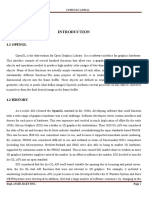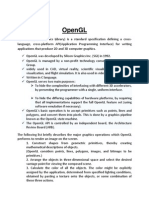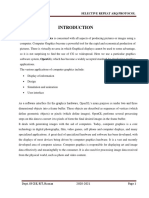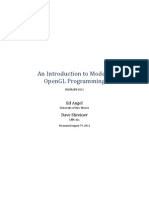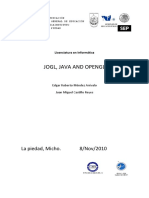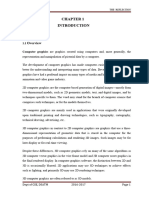Implimentation CG
Implimentation CG
Uploaded by
abhishekCopyright:
Available Formats
Implimentation CG
Implimentation CG
Uploaded by
abhishekOriginal Title
Copyright
Available Formats
Share this document
Did you find this document useful?
Is this content inappropriate?
Copyright:
Available Formats
Implimentation CG
Implimentation CG
Uploaded by
abhishekCopyright:
Available Formats
Demonstration of Doubly linked list
CHAPTER 1
INTRODUCTION
CS&E Dept, B.I.E.T, Davangere Page 1
Demonstration of Doubly linked list
1.1 OPENGL
OpenGL is the abbreviation for Open Graphics Library. It is a software interface for
graphics hardware. This interface consists of several hundred functions that allow you, a graphics
programmer, to specify the objects and operations needed to produce high-quality color images of
two-dimensional and three-dimensional objects. Many of these functions are actually simple
variations of each other, so in reality there are about 120 substantially different functions. The
main purpose of OpenGL is to render two-dimensional and three-dimensional objects into the
frame buffer. These objects are defined as sequences of vertices (that define geometric objects) or
pixels (that define images).OpenGL performs several processes on this data to convert it to pixels
to form the final desired image in the frame buffer.
1.1 HISTORY
As a result, SGI released the OpenGL standard In the 1980s, developing software that
could function with a wide range of graphics hardware was a real challenge. Software developers
wrote custom interfaces and drivers for each piece of hardware. This was expensive and resulted
in much duplication of effort.
By the early 1990s, Silicon Graphics (SGI) was a leader in 3D graphics for workstations.
Their IRIS GL API was considered the state of the art and became the de facto industry standard,
overshadowing the open standards-based PHIGS. This was because IRIS GL was considered easier
to use, and because it supported immediate mode rendering. By contrast, PHIGS was considered
difficult to use and outdated in terms of functionality.
SGI's competitors (including Sun Microsystems, Hewlett-Packard and IBM) were also able
to bring to market 3D hardware, supported by extensions made to the PHIGS standard. This in
turn caused SGI market share to weaken as more 3D graphics hardware suppliers entered the
market. In an effort to influence the market, SGI decided to turn the Iris GL API into an open
standard.
CS&E Dept, B.I.E.T, Davangere Page 2
Demonstration of Doubly linked list
SGI considered that the Iris GL API itself wasn't suitable for opening due to licensing and
patent issues. Also, the Iris GL had API functions that were not relevant to 3D graphics. For
example, it included a windowing, keyboard and mouse API, in part because it was developed
before the X Window System and Sun's NEWS systems were developed.
In addition, SGI had a large number of software customers; by changing to the OpenGL
API they planned to keep their customers locked onto SGI (and IBM) hardware for a few years
while market support for OpenGL matured. Meanwhile, SGI would continue to try to maintain
their customers tied to SGI hardware by developing the advanced and proprietary Iris Inventor and
Iris Performer programming APIs.
1.2 FEATURES OF OPENGL
Industry standard
An independent consortium, the OpenGL Architecture Review Board, guides the OpenGL
specification. With broad industry support, OpenGL is the only truly open, vendor-neutral,
multiplatform graphics standard.
Stable
OpenGL implementations have been available for more than seven years on a wide variety
of platforms. Additions to the specification are well controlled, and proposed updates are
announced in time for developers to adopt changes. Backward compatibility requirements
ensure that existing applications do not become obsolete.
Reliable and portable
All OpenGL applications produce consistent visual display results on any OpenGL API-
compliant hardware, regardless of operating system or windowing system.
Evolving
Because of its thorough and forward-looking design, OpenGL allows new hardware
innovations to be accessible through the API via the OpenGL extension mechanism. In
this way, innovations appear in the API in a timely fashion, letting application developers
and hardware vendors incorporate new features into their normal product release cycles.
CS&E Dept, B.I.E.T, Davangere Page 3
Demonstration of Doubly linked list
Scalable
OpenGL API-based applications can run on systems ranging from consumer electronics to
PCs, workstations, and supercomputers. As a result, applications can scale to any class of
machine that the developer chooses to target.
Easy to use
OpenGL is well structured with an intuitive design and logical commands. Efficient
OpenGL routines typically result in applications with fewer lines of code than those that
make up programs generated using other graphics libraries or packages. In addition,
OpenGL drivers encapsulate information about the underlying hardware, freeing the
application developer from having to design for specific hardware features.
Well-documented
Numerous books have been published about OpenGL, and a great deal of sample code is
readily available, making information about OpenGL inexpensive and easy to obtain.
1.3 BASIC OPENGL OPERATION
The following diagram illustrates how OpenGL processes data. As shown, commands enter
from the left and proceed through a processing pipeline. Some commands specify geometric
objects to be drawn, and others control how the objects are handled during various processing
stages.
Fig: 1.4 OpenGL Block Diagram
CS&E Dept, B.I.E.T, Davangere Page 4
Demonstration of Doubly linked list
The processing stages in basic OpenGL operation are as follows:
Display list
Rather than having all commands proceed immediately through the pipeline, you can
choose to accumulate some of them in a display list for processing later.
Evaluator
The evaluator stage of processing provides an efficient way to approximate curve and
surface geometry by evaluating polynomial commands of input values.
Per-vertex operations and primitive assembly
OpenGL processes geometric primitives - points, line segments, and polygons all of which
are described by vertices. Vertices are transformed, and primitives are clipped to the
viewport in preparation for rasterization.
Rasterization
The rasterization stage produces a series of frame-buffer addresses and associated
values using a two-dimensional description of a point, line segment, or polygon. Each so
produced is fed into the last stage, per-fragment operations.
Per-fragment operations
These are the final operations performed on the data before it is stored as pixels in the
frame buffer Per-fragment operations include conditional updates to the frame buffer based
on incoming and previously stored z values (for z buffering) and blending of incoming
pixel colors with stored colors, as well as masking and other logical operations on pixel
values.
CS&E Dept, B.I.E.T, Davangere Page 5
Demonstration of Doubly linked list
Pixel operation
Input data can be in the form of pixels rather than vertices. Such data which might describe
an image for texture mapping skips the first stage of processing and instead processed as
pixels in the pixel operation stage.
Texture memory
The result of pixel operation stage is either stored as texture memory for use in rasterization
stage or rasterised and resulting fragment merged into the frame buffer just as they were
generated from the geometric data.
1.4 THE OPENGL INTERFACE
Most of our applications will be designed to access OpenGL directly through functions in three
libraries. They are
GL – Graphics Library
Functions in the main GL (or OpenGL in Windows) library have names that begin with the
letters gl and are stored in a library usually referred to as GL (or OpenGL in Windows).
GLU – Graphics Utility Library
This library uses only GL functions but contain code for creating common objects and
simplifying viewing. All functions in GLU can be created from the core GL library but
application programmers prefer not to write the code repeatedly. The GLU library is
available in all OpenGL implementations; functions in the GLU library begins with the
letters glu.
GLUT – OpenGL Utility Toolkit
To interface with the window system and to get input from external devices into our
programs we need at least one more library. For the X window System, this library is called
GLX, for Windows, it is wgl, and for the Macintosh, it is agl. Rather than using a different
CS&E Dept, B.I.E.T, Davangere Page 6
Demonstration of Doubly linked list
library for each system, we use a readily available library called the OpenGL Utility Toolkit
(GLUT) , which provides minimum functionality that should be expected in any modern
windowing system.
Fig: 1.5 Library Organization
The above figure shows the organization of the libraries for an X Window System
environment.
In most implementations, one of the include lines
#include<GL/glut.h>
or
#include<GLUT/glut.h>
is sufficient to read in glut.h, gl.h and glu.h.
1.5 GRAPHICS FUNCTIONS
Our basic model of a graphics package is a black box, a term that engineers use to denote
a system whose properties are described only by its inputs and outputs; we may know nothing
about its internal workings.
CS&E Dept, B.I.E.T, Davangere Page 7
Demonstration of Doubly linked list
OpenGL functions can be classified into seven major groups:
Primitive function The primitive functions define the low-level objects or atomic entities
that our system can display. Depending on the API, the primitives can include points, lines,
polygons , pixels, text, and various types of curves and surfaces.
Attribute functions
If primitives are the what of an API – the primitive objects that can be displayed- then
attributes are the how. That is, the attributes govern the way the primitive appears on the
display. Attribute functions allow us to perform operations ranging from choosing the color
with which we display a line segment, to picking a pattern with which to fill inside of a
polygon.
Viewing functions
The viewing functions allow us to specify various views, although APIs differ in the degree
of flexibility they provide in choosing a view.
Transformation functions
One of the characteristics of a good API is that it provides the user with a set of
transformations functions such as rotation, translation and scaling.
Input functions
For interactive applications, an API must provide a set of input functions, to allow users to
deal with the diverse forms of input that characterize modern graphics systems. We need
functions to deal with devices such as keyboards, mice and data tablets.
Control functions
These functions enable us to communicate with the window system, to initialize our
programs, and to deal with any errors that take place during the execution of our programs.
Query functions
CS&E Dept, B.I.E.T, Davangere Page 8
Demonstration of Doubly linked list
If we are to write device independent programs, we should expect the implementation of
the API to take care of the differences between devices, such as how many colors are
supported or the size of the display. Such information of the particular implementation
should be provides through a set of query functions.
1.6 DATA TYPES
OpenGL supports different data types. A list of data types supported by OpenGL is given
in the following table.
Sl no. Suffix Data type C type OpenGL type
1. B 8 bit int signed int GLbyte
2. S 1 bit int Short GLshort
3. I 32 bit int Long GLint , GLsizei
4. F 32 bit float Float GLfloat ,GLclampf
5. D 64 bit float Double GLdouble,
GLclampd
6. Ub 8 bit unsigned unsigned char GLubyte, GLboolean
7. Us 16 bit unsigned unsigned short GLushort
8. Ui 32 bit unsigned unsigned int GLuint, GLenum,
GLbitfield
Table: 1.1 DATA TYPES LIST
CS&E Dept, B.I.E.T, Davangere Page 9
Demonstration of Doubly linked list
CHAPTER 2
SYSTEM REQUIREMENTS
2.1 SOFTWARE REQUIREMENTS
1. Operating System : Microsoft Windows XP,Microsoft Windows 7
2. Compiler used: VC++ 6.0 compiler
3. Language used: Visual C++
2.2 HARDWARE REQUIREMENTS
1. Processor: PENTIUM III
2. Processor Speed: 800 MHz
3. RAM Size: 128MB DDR
4. Compatibility: AT/T compatible
5. Cache Memory: 256 KB
CS&E Dept, B.I.E.T, Davangere Page 10
Demonstration of Doubly linked list
CHAPTER 3
SYSTEM DESIGN
3.1 INITIALIZATION
Initialize to interact with the Windows.
Initialize the display mode that is double buffer and RGB color system.
Initialize window position and window size.
Initialize and create the window to display the output.
3.2 DISPLAY
Menus are created and depending on the value returned by menus.
Suitable operations are performed.
The operations performed are:
o Insert front
o Insert rear
o Insert left
o Insert right
o Delete front
o Delete rear
o Delete specified
o Exit
3.3 FLOW CHART
When we run the program, display screen and main window appears. On clicking right
button of mouse on main window the list of options like insert front, insert rear, insert left, insert
right, delete front, delete rear, delete specified, exit appears. By selecting any of these options we
can perform the specified operation on doubly linked list.
CS&E Dept, B.I.E.T, Davangere Page 11
Demonstration of Doubly linked list
START
DISPLAY SCREEN
MAIN WINDOW
YES
CLICK RIGHT BUTTON
YES
INSERT INSERT INSERT INSERT DELETE DELETE DELETE
FRONT REAR LEFT RIGHT FRONT REAR SPECIFIED EXIT
STOP
Fig: 3.3 Flow Chart
CS&E Dept, B.I.E.T, Davangere Page 12
Demonstration of Doubly linked list
CHAPTER 4
IMPLEMENTATION
4.1 OVERVIEW
In this project demonstration of doubly linked list operations are shown. We have taken
the help of built in functions present in the header file. To provide functionality to our project we
have written sub functions. These functions provide us the efficient way to design the project. In
this chapter we are describing the functionality of our project using these functions.
Mouse interactions are provided where, when a right button is pressed, menu displays and we
can select options from menu displayed.
4.2 USER INTERFACE
The Project which we have done uses OpenGL functions and is implemented using C.
Our Project is to demonstrate OPERATION OF DOUBLY LINKED LIST. User can perform
operations of doubly linked list.
Mouse interaction
When we right click the mouse button on the display window several options are available:
Insert front: It inserts a node at the front end.
Insert rear: It inserts a node at the rear end.
Insert left: It inserts a node to the left of the specified node.
Insert right: It inserts a node to the right of the specified node.
Delete front: It deletes the node from the front end.
Delete rear: It deletes the node from the rear end.
Delete specified: It deletes the specified node.
Exit: It is used to exit from the program.
4.3 STRUCTURE
void renderscene();
void init();
CS&E Dept, B.I.E.T, Davangere Page 13
Demonstration of Doubly linked list
NODE getnode();
void disp();
NODE display(NODE);
NODE insertfront(NODE,int);
NODE insertrear(NODE,int);
NODE insertleft(NODE,int);
NODE insertright(NODE,int);
NODE deletfront(NODE);
NODE deletrear(NODE);
NODE del(NODE,int);
void top_menu(int);
void main(int argc, char **argv);
4.4 ANALYSIS
FUNCTIONS
A function is a block of code that has a name and it has a property that it is reusable that is
it can be executed from as many different points in a c program as required.
The partial code of various function that have been used in the program are:
4.4.1 Init
void init()
glClearColor(1.0,1.0,1.0,0.0);
glColor3f(0.0f,0.0f,0.0f);
glPointSize(0.8);
glMatrixMode(GL_PROJECTION);
glLoadIdentity();
CS&E Dept, B.I.E.T, Davangere Page 14
Demonstration of Doubly linked list
gluOrtho2D(0.0,2000.0,0.0,400.0);
This function is used to initialize the graphics window.glMatrixMode(GL_PROJECTION),
glLoadIdentity() are used to project the output on to the graphics window. gluOrtho2D() is used
to set the viewing rectangle to size 2000X400
4.4.2 Display
NODE display(NODE head)
glClear(GL_COLOR_BUFFER_BIT);
NODE temp;
int i=0,k,j=0;
………..
………..
………..
temp=temp->rlink;
glFlush();
return head;
void disp()
glClear(GL_COLOR_BUFFER_BIT);
glColor3f(1.0,0.0,1.0);
char c[]="List is Empty";
CS&E Dept, B.I.E.T, Davangere Page 15
Demonstration of Doubly linked list
glRasterPos2f(800.0,200.0);
for(int i=0;c[i]!='\0';i++)
glutBitmapCharacter(GLUT_BITMAP_HELVETICA_18,c[i]);
glColor3f(1.0,1.0,1.0);
glBegin(GL_POLYGON);
glVertex2i(100,200);
glVertex2i(100,225);
glVertex2i(500,225);
glVertex2i(500,200);
glEnd();
glFlush();
If temp==head, i.e., if list is empty it invokes the disp() function. disp() function is used to
print the message list is empty on the graphics window. Otherwise it prints individual nodes on
the graphics window, and indicates the ‘info’ and ‘link’ fields in them.
It also prints number in each node.
4.4.3 Renderscene
void renderscene()
glClear(GL_COLOR_BUFFER_BIT);
glColor3f(1.0,0.3,0.0);
……………
……………
for(i=0;c5[i]!='\0';i++)
glutBitmapCharacter(GLUT_BITMAP_HELVETICA_18,c5[i]);
CS&E Dept, B.I.E.T, Davangere Page 16
Demonstration of Doubly linked list
glFlush();
This function is used to display the initial graphics window, before giving any input. It
displays the string like ‘computer graphics project’, ’name’, ‘college’, ‘press right button of mouse
to get various options’.
4.4.4 Getnode
NODE getnode()
NODE temp;
temp=(NODE)malloc(sizeof(struct node));
if(temp==NULL)
printf("out of memory\n");
exit(1);
return temp;
This function is used to allocate the required memory space, dynamically to each node.
Otherwise it prints an error.
4.4.5 Insert front
NODE insertfront(NODE head,int item)
NODE temp,cur;
temp=getnode();
temp->info=item;
cur=head->rlink;
CS&E Dept, B.I.E.T, Davangere Page 17
Demonstration of Doubly linked list
head->rlink=temp;
temp->llink=head;
temp->rlink=cur;
cur->llink=temp;
return head;
This function is used to insert the given node onto the front end of the list. Memory is
allocated to a node temp, and it is assigned with the given value, and its link is made to point to
the first node.
4.4.6 Insert rear
NODE insertrear(NODE head,int item)
NODE temp,cur;
temp=getnode();
temp->info=item;
………
………
cur->rlink=temp;
return head;
This function is used to insert node onto the rear end of the list. Memory is allocated to a
node temp, and it is assigned with the given value, and its link is assigned to NULL. We traverse
to the end of the list by making use of node pointer cur, and when it reaches the end of the list, link
of cur points to temp.
4.4.7 Insert left
NODE insertleft(NODE head,int ele)
CS&E Dept, B.I.E.T, Davangere Page 18
Demonstration of Doubly linked list
int item;
NODE temp,cur,pre;
if(head->rlink==head)
………
………
cur->llink=temp;
pre->rlink=temp;
return head;
This function is to insert the node on to the left of any node. Initially it searches the element
which we have specified and later on it inserts the newly specified node to the left of the searched
node.
4.4.8 Insert right
NODE insertright(NODE head,int ele)
int item;
glClear(GL_COLOR_BUFFER_BIT);
NODE temp,cur,next;
if(head->rlink==head)
………..
………..
………..
printf("%d element not found\n",ele);
count--;
CS&E Dept, B.I.E.T, Davangere Page 19
Demonstration of Doubly linked list
return head;
This function is to insert the node on to the right of any node. Initially it searches the
element which we have specified and later on it inserts the newly specified node to the right of the
searched node.
4.4.9 Delete Front
NODE deletfront(NODE head)
NODE cur,next;
………….
………….
printf("node to be deleted id %d\n",cur->info);
free(cur);
return head;
This function is used to delete individual node from the front end of the list .If the
list is empty it prints an error message.
4.4.10 Delete Rear
NODE deletrear(NODE head)
NODE cur,prev;
if(head->llink==head)
………
………
printf("node to be deleted is %d\n",cur->info);
free(cur);
CS&E Dept, B.I.E.T, Davangere Page 20
Demonstration of Doubly linked list
return head;
This function is to delete a node from rear end of the list. For this we make use of two node
pointers, cur and prev. If the list is empty it prints an error message.
4.4.11 Delete Specified
NODE del(NODE head,int ele)
NODE cur,next,pre;
glClear(GL_COLOR_BUFFER_BIT);
if(head->rlink==head)
…………
…………
next->llink=pre;
free(cur);
return head;
This function is used to delete the specified element from the list. And after deletion it
prints the message as “element found and deleted”.
4.4.12 Top menu
void top_menu(int option)
int ele;
switch(option)
case 1:
printf("enter item to be inserted\n");
CS&E Dept, B.I.E.T, Davangere Page 21
Demonstration of Doubly linked list
………..
………..
display(head);
break;
case 8:exit(0);
This function allows the user to choose the operation to be performed. It uses the switch-
case structure.
4.4.13 Main Function
void main(int argc,char** argv)
head=getnode();
head->rlink=head;
head->llink=head;
head->info=NULL;
glutInit(&argc,argv);
………..
………
init();
glutMainLoop();
The execution starts from main function. It is used to create the graphics window, set it’s
size, position and display mode. It is also used to create the menu.
CS&E Dept, B.I.E.T, Davangere Page 22
Demonstration of Doubly linked list
CHAPTER 5
SNAPSHOTS
1. After running the program
Fig 5.1: Home page
The above snapshot shows the screen displayed when the program gets runned.
2. Insert front
Fig 5.2: Insertion at front
CS&E Dept, B.I.E.T, Davangere Page 23
Demonstration of Doubly linked list
The above snapshot shows the operation of inserting element 1 to the front end of the doubly
linked list.
3. Insert rear
Fig 5.3: Insertion at rear
The above snapshot shows inserting element 2 to the rear end of doubly linked list.
4. Insert left
Fig 5.4: Insertion at the left of a node
The above snapshot shows inserting an element 3 at the left of the element 2 of doubly linked
list.
CS&E Dept, B.I.E.T, Davangere Page 24
Demonstration of Doubly linked list
5. Insert right
Fig 5.5: Insertion at the right of a node
The above snapshot shows inserting an element 4 to the right of element 2 of doubly linked list.
6. Delete front
Fig 5.6: Deleting front
The above snapshot shows deleting the front element 1 from the doubly linked list.
CS&E Dept, B.I.E.T, Davangere Page 25
Demonstration of Doubly linked list
7. Delete rear
Fig 5.7: Deleting rear
The above snapshot shows deleting the rear element 4 from the doubly linked list.
8. Delete specified
Fig 5.8: Deleting specified element
The above snapshot shows deleting the specified element 2 from the doubly linked list.
CS&E Dept, B.I.E.T, Davangere Page 26
You might also like
- Stage 8 Cambridge ICT Revision TestDocument12 pagesStage 8 Cambridge ICT Revision Testnguyenchuong.hoangNo ratings yet
- Computer Graphics ReportDocument31 pagesComputer Graphics ReportShalini G Gowda100% (1)
- 1.1 Opengl: Rain Water HarvestingDocument22 pages1.1 Opengl: Rain Water HarvestingSPOORTHI SNo ratings yet
- 1.1 Opengl: Cineplex ArenaDocument21 pages1.1 Opengl: Cineplex ArenaShashank SNo ratings yet
- 1.1 Opengl: Rain Water HarvestingDocument22 pages1.1 Opengl: Rain Water HarvestingSPOORTHI SNo ratings yet
- CGREPORTDocument25 pagesCGREPORTPoojaNo ratings yet
- "Perplexity": A Simple Maze GameDocument32 pages"Perplexity": A Simple Maze GameNawaz KumanaliNo ratings yet
- CG22Document17 pagesCG22l70669985No ratings yet
- INTRODUCTION1Document29 pagesINTRODUCTION1The UltimateNo ratings yet
- UNIT - I Part IIDocument76 pagesUNIT - I Part IImangobanana0709No ratings yet
- Chapter 1Document15 pagesChapter 11JS19CS188 Vijay NaikNo ratings yet
- Open GLDocument4 pagesOpen GLTage NobinNo ratings yet
- BY: Supriya P (1RR18CS145) Thoshitha C (1RR18CS150) : Rajarajeshwari College of EngineeringDocument29 pagesBY: Supriya P (1RR18CS145) Thoshitha C (1RR18CS150) : Rajarajeshwari College of EngineeringSupriya P100% (2)
- Data Comunication Using Open GLDocument14 pagesData Comunication Using Open GLkomal sagar yadavNo ratings yet
- ARQ ReportDocument47 pagesARQ ReportNandita IyerNo ratings yet
- Appendix: Opengl-A Quick Start: Structure Page NoDocument17 pagesAppendix: Opengl-A Quick Start: Structure Page NoMuhammad SahilNo ratings yet
- @ Definitive OpenglDocument163 pages@ Definitive OpenglRecursao de RecuperacaoNo ratings yet
- Selective Repeat ArqDocument234 pagesSelective Repeat Arqpriya shashikumarNo ratings yet
- Intro To Modern OpenGL ProgrammingDocument136 pagesIntro To Modern OpenGL ProgrammingPrashanth KpNo ratings yet
- Chapter 2 - CG (2024)Document11 pagesChapter 2 - CG (2024)tam858267No ratings yet
- DYNAMIC SORTING ALGORITHM VISUALIZER USING OPENGL ReportDocument35 pagesDYNAMIC SORTING ALGORITHM VISUALIZER USING OPENGL ReportSneha Sivakumar88% (8)
- Lab Manual Computer Graphics Laboratory With Mini Project (18CSL67)Document40 pagesLab Manual Computer Graphics Laboratory With Mini Project (18CSL67)abhishekNo ratings yet
- Page Index: Chapter No. Topic 1 2 Grid 3 Requirement SpecificationsDocument14 pagesPage Index: Chapter No. Topic 1 2 Grid 3 Requirement SpecificationssgsNo ratings yet
- Chapter ThreeDocument68 pagesChapter ThreejosapzedmanNo ratings yet
- Write The Case Study of Open GLDocument6 pagesWrite The Case Study of Open GLapi-3703205No ratings yet
- Ayush Raj Singh - CGVR - MINIPROJECTDocument18 pagesAyush Raj Singh - CGVR - MINIPROJECTAyush Raj SinghNo ratings yet
- CG Synopsis 2019-1Document5 pagesCG Synopsis 2019-1alexa0104002 amazonNo ratings yet
- Real-Time Translator From OpenGL To OpenGL ES ForDocument4 pagesReal-Time Translator From OpenGL To OpenGL ES ForElmerNo ratings yet
- Unit-5 CGDocument10 pagesUnit-5 CGvasanthsm2006No ratings yet
- Isro ReportDocument32 pagesIsro Reportsalim07238No ratings yet
- CG Lab ManualDocument52 pagesCG Lab ManualSrisaila NathNo ratings yet
- Analog ClockDocument18 pagesAnalog Clocksreenivasan knNo ratings yet
- College Department Course: B.E Course Code 18CSL67 Student Name USN Mini Project Title Under Taken at Internal Guide SynopsisDocument3 pagesCollege Department Course: B.E Course Code 18CSL67 Student Name USN Mini Project Title Under Taken at Internal Guide Synopsismohit kunduNo ratings yet
- ReportDocument22 pagesReportShashank Shashank. A. RNo ratings yet
- Airplane Game ReportDocument41 pagesAirplane Game ReportResh ReshmaNo ratings yet
- OpenGL FunctionsDocument34 pagesOpenGL Functionssandywaits4u31No ratings yet
- CG - MANUAL (18 Scheme) bmk2021Document51 pagesCG - MANUAL (18 Scheme) bmk2021Manasa KrishnaNo ratings yet
- Car ModelDocument36 pagesCar Modelshashank776052No ratings yet
- Open GL Project 6th Sem Hawk Eye by NasarDocument19 pagesOpen GL Project 6th Sem Hawk Eye by Nasarnasar_the_max75% (4)
- OpenGL in JAVA For JOGLDocument49 pagesOpenGL in JAVA For JOGLEdgar Roberto Mendez ArevaloNo ratings yet
- Chapter - 1: Aeroplane CrashDocument18 pagesChapter - 1: Aeroplane CrashBharaniNo ratings yet
- Open GLDocument8 pagesOpen GLChala Simon FikaduNo ratings yet
- CG Lab ManualDocument41 pagesCG Lab ManualSindhuNo ratings yet
- Optimizing 2D Graphics With Openvg and I.Mx35Document20 pagesOptimizing 2D Graphics With Openvg and I.Mx35Rajesh TengliNo ratings yet
- CG Lab FileDocument46 pagesCG Lab FileDivyansh SinghNo ratings yet
- Chapter-1: Tower of HanoiDocument28 pagesChapter-1: Tower of HanoiTameemuddinNo ratings yet
- Project ReportDocument23 pagesProject ReportMurali Manohar Krishna G67% (3)
- Introduction To OpenglDocument6 pagesIntroduction To Openglps9473013No ratings yet
- Opengl_report-1.1Document37 pagesOpengl_report-1.1dishagowda2311No ratings yet
- CGVManual - 2017 - 18 - ModifiedDocument69 pagesCGVManual - 2017 - 18 - ModifiedakarshNo ratings yet
- Description of The ProjectDocument25 pagesDescription of The ProjectTanveer PatelNo ratings yet
- Complete ReportDocument33 pagesComplete Report1ep21cs041.cseNo ratings yet
- 1.1 Computer Graphics: Multi Level Mirror EffectDocument14 pages1.1 Computer Graphics: Multi Level Mirror EffectHarshitha HarshuNo ratings yet
- Presentation 1Document6 pagesPresentation 1seafadesNo ratings yet
- An Introduction On OpenGL With 2D Graphics - OpenGL TutorialDocument37 pagesAn Introduction On OpenGL With 2D Graphics - OpenGL TutorialGunnie PandherNo ratings yet
- CG Report NCC-2Document40 pagesCG Report NCC-2sakshi sNo ratings yet
- Op EnglDocument9 pagesOp EnglraphaelzeroNo ratings yet
- Professional WebGL Programming: Developing 3D Graphics for the WebFrom EverandProfessional WebGL Programming: Developing 3D Graphics for the WebNo ratings yet
- OpenCL Programming by Example: A comprehensive guide on OpenCL programming with examples with this book and ebookFrom EverandOpenCL Programming by Example: A comprehensive guide on OpenCL programming with examples with this book and ebookNo ratings yet
- C++ Game Animation Programming: Learn modern animation techniques from theory to implementation using C++, OpenGL, and VulkanFrom EverandC++ Game Animation Programming: Learn modern animation techniques from theory to implementation using C++, OpenGL, and VulkanNo ratings yet
- CG ReportDocument32 pagesCG ReportabhishekNo ratings yet
- OSHA AssignmentDocument10 pagesOSHA AssignmentabhishekNo ratings yet
- CG-report123 FinalDocument40 pagesCG-report123 FinalabhishekNo ratings yet
- Adobe Scan Jun 27, 2023Document13 pagesAdobe Scan Jun 27, 2023abhishekNo ratings yet
- 1.1 Android Studio: Step Counter AppDocument12 pages1.1 Android Studio: Step Counter AppabhishekNo ratings yet
- Ilovepdf MergedDocument35 pagesIlovepdf MergedabhishekNo ratings yet
- Mad RepDocument32 pagesMad RepabhishekNo ratings yet
- 4BD20CS004,4BD20CS040Document38 pages4BD20CS004,4BD20CS040abhishekNo ratings yet
- Onroad Vehicle Breakdown Help Asssitance (1) - 2Document9 pagesOnroad Vehicle Breakdown Help Asssitance (1) - 2abhishekNo ratings yet
- Bharat Scanner 05 Jul 2 CDocument22 pagesBharat Scanner 05 Jul 2 CabhishekNo ratings yet
- CG Lab ManualDocument18 pagesCG Lab ManualabhishekNo ratings yet
- 4BD20CS004,4BD20CS040Document43 pages4BD20CS004,4BD20CS040abhishekNo ratings yet
- Biet Madlabmanual18csmp68.Docx 20 62Document43 pagesBiet Madlabmanual18csmp68.Docx 20 62abhishekNo ratings yet
- Module 3 18CS63Document43 pagesModule 3 18CS63abhishekNo ratings yet
- CG-report123 FinalDocument40 pagesCG-report123 FinalabhishekNo ratings yet
- SS CD Os 18CSL66Document57 pagesSS CD Os 18CSL66abhishekNo ratings yet
- OOC 18CS45 Module2 TieDocument38 pagesOOC 18CS45 Module2 TieabhishekNo ratings yet
- Chapter 1 CGDocument1 pageChapter 1 CGabhishekNo ratings yet
- 4BD20CS004,4BD20CS040Document39 pages4BD20CS004,4BD20CS040abhishekNo ratings yet
- Module 4 18CS63Document39 pagesModule 4 18CS63abhishekNo ratings yet
- New Microsoft Word DocumentDocument3 pagesNew Microsoft Word DocumentabhishekNo ratings yet
- Web CerificateDocument1 pageWeb CerificateabhishekNo ratings yet
- OOC Mod2@AzDOCUMENTS - inDocument28 pagesOOC Mod2@AzDOCUMENTS - inabhishekNo ratings yet
- 18ME751 UnlockedDocument2 pages18ME751 UnlockedabhishekNo ratings yet
- Configure Your First Automation - Step-by-Step InstructionsDocument20 pagesConfigure Your First Automation - Step-by-Step InstructionsabhishekNo ratings yet
- ACOP Manager Software ManualDocument15 pagesACOP Manager Software ManualDiana GarciaNo ratings yet
- Introduction To Pseudocode: Rikip GinanjarDocument82 pagesIntroduction To Pseudocode: Rikip GinanjarSyhr AlydrsNo ratings yet
- TPL SDSDocument10 pagesTPL SDSPraveenNo ratings yet
- Bordering Text BI PublisherDocument8 pagesBordering Text BI PublisherAlex ValenciaNo ratings yet
- WEB RecordDocument59 pagesWEB RecordYamadaNo ratings yet
- HDI Initial Configuration v1-0Document67 pagesHDI Initial Configuration v1-0fqchinaNo ratings yet
- The Need For Speed: An Introduc+on To Website PerformanceDocument49 pagesThe Need For Speed: An Introduc+on To Website PerformanceSwetha SrikanthiNo ratings yet
- 02 Spring Boot Spring CoreDocument117 pages02 Spring Boot Spring CoreChotuNo ratings yet
- Bukti Digital Dan Bookmark Brian-Carrier - Introduction-To-AutopsyDocument38 pagesBukti Digital Dan Bookmark Brian-Carrier - Introduction-To-AutopsyQadritechNo ratings yet
- CS 101Document16 pagesCS 101Gianluca PerroneNo ratings yet
- Oracle PLSQL Performance Tuning SyllabusDocument2 pagesOracle PLSQL Performance Tuning Syllabusoraappsforum100% (2)
- Air Canvas SynopsisDocument23 pagesAir Canvas SynopsisRahul RajNo ratings yet
- Change LogDocument303 pagesChange LogFahad AhmedNo ratings yet
- DVClub UVM RegistersDocument16 pagesDVClub UVM RegistersjagdishNo ratings yet
- CSYM019 Internet Programming Assignment Brief - March 2023 (1) - 1Document10 pagesCSYM019 Internet Programming Assignment Brief - March 2023 (1) - 1Dan DavidNo ratings yet
- AssignmentsDocument3 pagesAssignmentsKeshavNo ratings yet
- REV.1 - Steel Bridge - FEB - 2022Document3 pagesREV.1 - Steel Bridge - FEB - 2022Rauuf YusofNo ratings yet
- Icf Reviewer Quarter 1 Grade 8Document6 pagesIcf Reviewer Quarter 1 Grade 8blehbloopblehbloopNo ratings yet
- Programming with Microsoft Visual Basic 2017 8th Edition Diane Zak 2024 scribd downloadDocument51 pagesProgramming with Microsoft Visual Basic 2017 8th Edition Diane Zak 2024 scribd downloadrainsarceo6y100% (4)
- Student Java Online Documentation AdvancDocument35 pagesStudent Java Online Documentation AdvancVijayNo ratings yet
- Course AllocationDocument35 pagesCourse AllocationHASSAN LAWAL ULINo ratings yet
- Chapter OneDocument24 pagesChapter OneAbenezer TeshomeNo ratings yet
- FC Vs FBDocument8 pagesFC Vs FBMiguel SanchesNo ratings yet
- IBM Lotus Notes and Domino 7Document55 pagesIBM Lotus Notes and Domino 7baskaransethuNo ratings yet
- Aptitude Questions: Answer and ExplanationDocument179 pagesAptitude Questions: Answer and ExplanationParneet KaurNo ratings yet
- Custom Dialog Box Message while Saving the Adobe Forms without filling the Mandatory FieldsDocument10 pagesCustom Dialog Box Message while Saving the Adobe Forms without filling the Mandatory FieldsRathin ChakrabartyNo ratings yet
- WelcomeDocument23 pagesWelcomeabiramanNo ratings yet
- BCA 1ST YEAR (Unit-1)Document37 pagesBCA 1ST YEAR (Unit-1)ghatiyashivani48100% (1)
- Teradata Vantage™ - Workload Management: User GuideDocument115 pagesTeradata Vantage™ - Workload Management: User GuideGowtham KumarNo ratings yet



